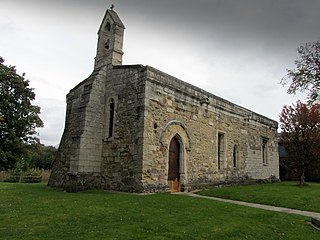
Edward Hodges Baily was a prolific British sculptor responsible for numerous public monuments, portrait busts, statues and exhibition pieces as well as works in silver. He carved friezes for both the Marble Arch and Buckingham Palace in London. His numerous statues of public figures include that of Horatio Nelson on top of Nelson's Column and Charles Grey, 2nd Earl Grey on Grey's Monument in Newcastle upon Tyne. Throughout his career Baily was responsible for creating a number of monuments and memorials for British churches and cathedrals, including several in St Paul's Cathedral.

Friends of Friendless Churches (FoFC) is a registered charity formed in 1957, active in England and Wales, which campaigns for and rescues redundant historic places of worship threatened by demolition, decay, or inappropriate conversion. As of April 2021, the charity owns 58 redundant churches or chapels, 29 of which are in England, and 29 in Wales.

St Lawrence Jewry next Guildhall is a Church of England guild church in the City of London on Gresham Street, next to the Guildhall. It was destroyed in the Great Fire of London in 1666, and rebuilt to the designs of Sir Christopher Wren. It is the official church of the Lord Mayor of London.

Frederick William Pomeroy was a prolific British sculptor of architectural and monumental works. He became a leading sculptor in the New Sculpture movement, a group distinguished by a stylistic turn towards naturalism and for their works of architectural sculpture. Pomeroy had several significant public works in London and elsewhere in the United Kingdom, notably in Belfast. His work in London includes the figure of Lady Justice (1905–1906) on the dome of the Old Bailey.
Mendip is a local government district in the English county of Somerset. The Mendip district covers a largely rural area of 285 square miles (738 km2) ranging from the Mendip Hills through on to the Somerset Levels. It has a population of approximately 11,000. The administrative centre of the district is Shepton Mallet.

St Mary Magdalen's Church is a Roman Catholic church in the Montpelier area of Brighton, part of the English city of Brighton and Hove. Dedicated to Jesus' companion Mary Magdalene, it is one of six Roman Catholic churches in Brighton and one of eleven in the city area. Built by ecclesiastical architect Gilbert Blount in a 13th-century Gothic style to serve the rapidly expanding residential area on the border of Brighton and Hove, it has been listed at Grade II by English Heritage in view of its architectural importance. An adjacent presbytery and parish hall have been listed separately at Grade II.

St Mary's Church is in Walton, Liverpool, Merseyside, England. It is an active Anglican parish church in the deanery of Walton, the archdeaconry of Liverpool and the diocese of Liverpool. Its benefice is united with those of St Nathanael, Walton-on-the-Hill, and St Aidan, Walton-on-the-Hill, to form the Walton Team Ministry. The church is recorded in the National Heritage List for England as a designated Grade II listed building.
St Annes on the Sea is a town in the Borough of Fylde, Lancashire, England. It contains 23 listed buildings that are recorded in the National Heritage List for England. Of these, one is listed at Grade II*, the middle of the three grades, and the others are at Grade II, the lowest grade. Until the 1870s the only buildings in the area now occupied by the town were scattered cottages. In 1873 the architects Maxwell and Tuke were appointed to draw up a plan for the development of the town. This has since grown to become a seaside resort and commuter town. The listed buildings include churches and associated structures, public buildings, a hotel and its boundary wall, memorials, a bank, and a former school. The structures relating to the town's function as a resort are a pier, a pavilion and shelters, fountains, and a bandstand.

The Chapel of St Mary Magdalen, Ripon, is an active Anglican church on Magdalens Road in the city of Ripon, North Yorkshire, England. The chapel, which is dedicated to Jesus' companion Mary Magdalene, is quite close to Ripon Cathedral, and belongs to the cathedral's benefice, deanery and archdeaconry. The chapels' origins lie in the 12th century when it was built at the behest of Archbishop Thurstan. It was situated opposite the St Mary Magdalen Hospital grounds, becoming the chapel to the hospital and the church for lepers initially, and then later, blind priests.








